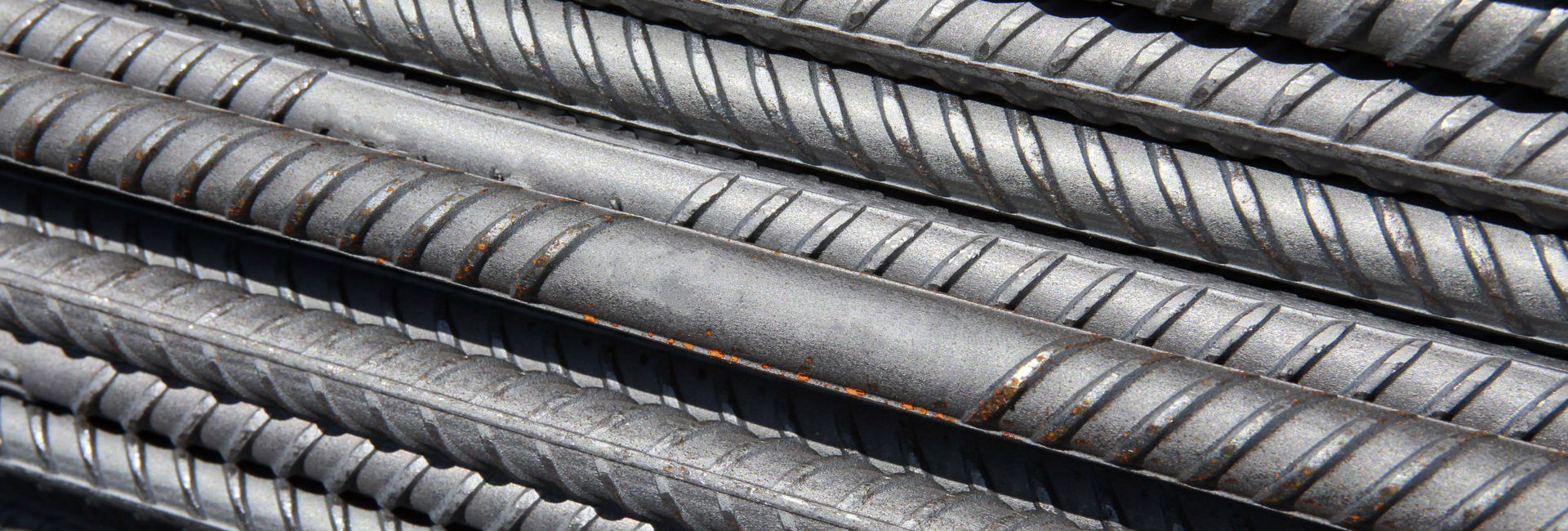During the construction of a building, the key aspects to look into are the strength of the structure to be built, as well as the reliability of the materials that will be employed. Although steel reinforcement bars are commonplace, their use is limited due to the high amount of corrosion they experience over time, particularly in coastal areas, as well as areas that experience high humidity or rainfall. This is where corrosion resistance in steel comes into play. Nowadays, modern corrosion-resistant TMT bars counteract the damaging impacts of rust, corrosion, and deterioration on structures, enabling them to provide safety and last for a significant period of time.
|
Table of Content
|
Steel reinforcement is irreplaceable in construction for providing strength and durability at a reasonable cost. Steel, however, is also very susceptible to rust in the presence of moisture, oxygen, and pollutants like chlorides. The answer comes in the form of rust-resistant steel, and in particular corrosion-resistant TMT bars, which provide substantial tensile strength while shielding against harsh environmental conditions.
Also Read: The Guide To Buying The Best TMT Bars
Also Read: What is TMT Bar: A Step-by-Step Guide to Their Advantages
The Importance of Corrosion Resistance in Construction
Steel corrosion is a slow but very damaging process. The corrosion of steel reinforcement bars starts when they come in contact with Water, Oxygen, and certain chemicals like Chlorides. The corrosion process reduces the cross-sectional area of the steel. This, in turn, weakens its load-bearing capacity, which compromises the safety of the structure as a whole.
Using corrosion-resistant steel TMT bars ensures:
- Longer Structural Life: Enhancing longevity by reducing rust damage.
- Reduced Maintenance Costs: Minimising the repair and maintenance efforts.
- Safety: Neglects progressive weakening of concrete together with steel bonding.
- Sustainability: Minimises the amount of necessary resource materials to be spent.
Essentially, rust-resistant steel provides protection, but its true value lies in the prospective reduced cost of maintenance, protection, repair work, and enduring the passage of time, along with environmental factors.
The Design and Composition of Corrosion-Resistant TMT Bars
Corrosion-resistant TMT Bars have a technological secret. Unlike ordinary bars, they are made with certain alloying elements that provide a higher resistance to rust and oxidation, improving their longevity.
1. Alloying Elements
- Copper, Chromium and Phosphorus are to be blended, which steel is composed of.
- Forming these elements creates a protective oxide film that shields the bar surface, protecting it from moisture and oxygen.
2. Advanced Thermo-Mechanical Treatment (TMT)
- The TMT process creates a hardened outer layer while the centre remains softer and ductile.
- The hardened outer layer provides environmental exposure resistance, while the inner core provides flexibility and resilience.
3. Passivation Layer
- Passive film formation on the surface of the steel is enhanced by the alloying elements.
- The film protects steel from reacting with chloride ions prevalent in saline or coastal regions.
The combination of high tensile strength and corrosion resistance, these bars outperform regular steel reinforced bars.
1. Increased Longevity
- The reduced rust formation attributed to corrosion-resistant steel TMT bars extends the lifespan of buildings and infrastructure.
2. Maintains Strength Bond with Concrete
- The ribs not only provide a strong bond with concrete, but the surface remains rust-free, capable of maintaining strength for decades.
3. Chloride Attack Resistance
- Ideal for coastal regions and high groundwater salinity areas where ordinary bars quickly corrode.
4. Minimised Cracks and Breakage
- Enhanced ductility protects the bars from sudden failure during dynamic or seismic loading.
5. Cost Benefits Over Time
- Rust-resistant steel yields cost benefits by minimising the need for repairs, replacements, and maintenance, even though the initial outlay may be steep.
6. Sustainable Construction
- Fewer raw materials needed aligns with sustainable practices because the service life of the structure has increased.
Also Read: Cost-saving tips while buying TMT bars
Uses of Corrosion-Resistant Steel TMT Bars
Due to the nature of corrosion-resistant TMT bars, their increasing use is noted in construction projects prone to rust, especially in the following:
1. Coastal and Marine Constructions
- Extremely high chloride content in bridges, ports, and harbours.
- Protective measures against the corrosive effects of saline water and humid air.
2. Residential and Commercial Buildings
- Shopping centres, office buildings, and high-rise apartments in humid and coastal cities.
3. Infrastructure Projects
- Important projects such as tunnels, highways, and metro constructions, which need enduring reliability.
4. Water Treatment Plants and Dams
- Corrosion-resistant steel TMT bars are best suited for structures that are at a high risk of rusting due to constant water exposure.
5. Industrial Structures
- Exposed to harsh chemicals and pollutants, steel structures in factories and chemical plants.
Rust-resistant steel offers savings on maintenance, repairs, and servicing costs as it effectively ensures structural stability for these buildings.
Why Corrosion-Resistant TMT Bars are the Best Choice
The argument of which is better, normal TMT Bars or corrosion-resistant TMT Bars, tends to boil down to the price. While the normal bars may seem cheap to buy initially, their tendency to rust over time leads to heavy structural repairs.
On the other hand, rust-resistant steel guarantees:
- Safety of lives and property.
- Long durability.
- Better return on expenditure.
That is the main reason why contractors and builders throughout India have started to prefer the best TMT bars in India, especially those that have proven resistance to corrosion.
Key Features that Make them Stand Out
1. Key Features that Make them Stand Out
Can support heavy and seismic loads.
2. Corrosion Resistance
Prevents rusting through alloying and treatment.
3. Superior Weldability
Maintains strength during fabrication.
4. Superior Weldability
Has an energy-absorbing protective ductile core that safeguards structures from impacts during seismic events.
4. Superior Weldability
Has an energy-absorbing protective ductile core that safeguards structures from impacts during seismic events.
5. Fire Resistance
Safe in environments prone to fire, tolerating high temperatures.
Due to these characteristics, corrosion-resistant steel TMT bars are the prime selection for safe and modern construction for durability.
Criteria for Picking the Best TMT Bars in India
It is important to note that choosing the right corrosion-resistant TMT bars can be critical because of the number of manufacturers in the market. The following requirements can be particularly helpful:
1. Quality Certifications
- Check for ISO, BIS, and other verified documents that certify the brand's quality.
2. Manufacturing Process
- Preferably, select bars produced using the modern TMT and alloying methods.
3. Reputation of the Manufacturer
- Older companies usually deliver better quality control and assurance.
3. Testing and Standards
- Confirm compliance with Indian Standard IS 1786 for reinforcement steel.
Reinforcement steel is critical in forming the backbone of any structure. Builders should not compromise on standard quality.
Construction and the Future of Rust-Resistant Steel
Building materials that are sustainable and can stand the test of time are in high demand, particularly as urbanization increases. Due to its durability in extreme conditions, corrosion-resistant steel TMT bars are rapidly gaining acceptance in modern construction. Builders are likely to embrace rust-resistant steel more as the focus on structural integrity increases.
In addition, the ongoing advancements in alloying, steelmaking, and refining will enhance corrosion resistance. Future buildings will therefore be strengthened and become more durable than ever.
Conclusion
The building's durability strongly correlates with the quality of materials used. The two key materials, concrete and steel, offer a peculiar combination where concrete serves as the body and reinforced steel as the skeleton of the structure. Flexibility and strength are essential for a building, but the ordinary steel used for reinforcement tends to rust, which poses a potential danger to the structure's health and safety.
Builders can use corrosion-resistant steel TMT bars to ensure a lower cost of maintenance and overcome rust challenges. These bars are essential for long-term sustainable construction and provide unparalleled strength for coastal projects, high-rise and Industrial buildings.
Sree Metaliks stands as one of the leading steel producers in the market and keeps a commitment to provide the best TMT bars in India. Builders and developers who are focused on constructing buildings with advanced technology and quality and seek enhanced safety and durability, trust Sree Metaliks because of the unmatched corrosion resistance, strength and durability of the TMT bars.
For more information, please reach out to us at: Sales@sreemetaliks.com

